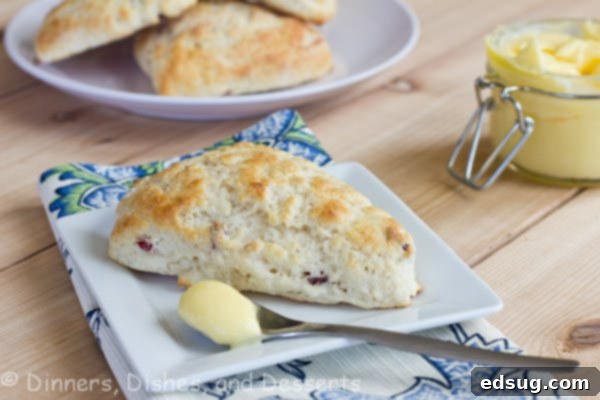Mastering the Art of Scones: Easy Homemade Cranberry Delights
There’s a special kind of satisfaction that comes from finally ticking an item off your culinary bucket list, especially when it involves something as delightful as freshly baked scones. For what feels like an eternity, making homemade scones has been at the very top of my baking aspirations. I’ve admired countless scone recipes shared by fellow food bloggers, always commenting on my desire to try my hand at them. Well, the wait is officially over! I’m thrilled to share that I’ve successfully baked my first batch of incredibly soft and tender cranberry scones, and the experience was far easier and more rewarding than I ever anticipated.
The Perfect Pairing: From Lemon Curd to Luscious Scones
The journey to these wonderful scones began shortly after I whipped up a batch of my Meyer Lemon Curd. With its bright, tangy, and sweet profile, I immediately started brainstorming the perfect accompaniment. What could possibly complement the creamy richness of lemon curd better than a warm, crumbly scone? The idea sparked an immediate inspiration, and I knew it was time to finally embrace the challenge. The combination of tart lemon curd with a buttery, slightly sweet scone is, in my humble opinion, pure culinary harmony. It’s a match made in heaven that elevates a simple breakfast or afternoon tea into a truly memorable occasion.
Discovering the Ideal Recipe: A Trusty Source
When embarking on a new baking adventure, I often turn to trusted sources for reliable recipes. My well-worn Cook’s Illustrated cookbook is always a go-to, known for its meticulous testing and foolproof methods. I was delighted to find several scone variations within its pages. Opting for a classic approach, I chose their basic scone recipe as my foundation. While the original called for currants, I decided to adapt it slightly by incorporating dried cranberries instead. This minor alteration proved to be a fantastic choice, adding a beautiful burst of color and a delightful tartness that perfectly balanced the sweetness of the scone.
A Family Affair: Rave Reviews from Everyone
One of the most rewarding aspects of baking is sharing the results with loved ones, and these scones certainly garnered widespread approval. The entire family enjoyed them immensely, which is always a triumph in my kitchen! My husband, usually not one for overly sweet breakfast items (unless it’s a donut, of course!), was pleasantly surprised. He genuinely liked these scones, a testament to their balanced flavor and perfect texture. His only request for next time? A savory scone! This opens up a whole new world of possibilities for future baking experiments. My 6-year-old also gave them a big thumbs up, declaring them “great,” though he preferred his scone plain rather than with the lemon curd. It just goes to show that everyone has their own preference, and these scones are versatile enough to please all palates.
The Simplicity of Scone Baking & Future Culinary Explorations
What truly excites me about this experience is how surprisingly easy these scones were to make. For years, I had built up scone baking in my mind as a complex endeavor, but this recipe proved otherwise. The process was straightforward, and the results were nothing short of spectacular. This newfound confidence means you can bet your bottom dollar that various scone versions will be making regular appearances in our home. From experimenting with different dried fruits and spices to diving into savory options like cheese and herb scones, the possibilities are endless. This recipe is not just a one-off success; it’s a gateway to a world of delicious, homemade baked goods.
What Makes a Scone So Special? Understanding the Basics
Scones, a beloved pastry, trace their origins back to Scotland and are a cornerstone of British tea time traditions. They are essentially quick breads, characterized by their light, tender, and slightly crumbly texture. Unlike biscuits, which tend to be more savory, scones often lean sweeter, incorporating fruits, sugar, and sometimes even clotted cream directly into the dough. The key to a truly exceptional scone lies in its delicate balance of richness and lightness, a quality achieved through careful ingredient selection and proper technique. These cranberry scones embody all the best qualities: they’re buttery, subtly sweet, and wonderfully fluffy, making them an irresistible treat at any time of day.
Tips for Achieving Scone Perfection: Your Guide to Fluffy Texture
Creating softer and tender scones is less about magic and more about mastering a few simple techniques:
- Keep Ingredients Cold: Cold butter is paramount. As the butter melts in the hot oven, it creates pockets of steam, resulting in a flaky, tender texture. If your butter gets too warm, pop it back in the fridge.
- Don’t Overmix: Overworking the dough develops gluten, leading to tough scones. Mix just until the ingredients are combined and a rough dough forms.
- Heavy Cream is Your Friend: While whole milk can be substituted (as I did in a pinch!), heavy cream offers a higher fat content, contributing to a richer flavor and a more tender crumb.
- High Heat is Key: Baking scones at a high temperature (450°F / 230°C) helps them rise quickly and form a beautiful golden-brown crust while keeping the interior moist.
- Gentle Handling: When shaping and cutting the dough, handle it as little as possible. This maintains the tender texture and prevents them from becoming dense.
Cranberry Scones

These cranberry scones are incredibly softer and tender, a delightful treat for any occasion.
10 minutes
15 minutes
25 minutes
Ingredients for Cranberry Scones
- 2 cups (10 oz) All-Purpose Flour
- 1 Tbls Baking Powder
- 3 Tbls Granulated Sugar
- 1/2 tsp Salt
- 5 Tbls unsalted butter, very cold and cut into small pieces
- 1/2 cup Dried Cranberries, roughly chopped
- 1 cup Heavy Cream, (or whole milk if heavy cream is unavailable)
Step-by-Step Instructions
- Preheat Oven: Preheat your oven to a blazing 450 degrees Fahrenheit (230°C). This high temperature is crucial for a good rise.
- Combine Dry Ingredients: In a food processor, pulse together the flour, sugar, baking powder, and salt until they are well combined (about 3 quick pulses). Evenly sprinkle the cold, cubed butter over the flour mixture. Pulse again until the mixture resembles coarse sand with some pea-sized pieces of butter still visible (approximately 12 pulses). Transfer this mixture to a large mixing bowl. Gently fold in the chopped dried cranberries.
- Form the Dough: Pour in the heavy cream (or whole milk) and stir with a spatula or wooden spoon just until the ingredients start to come together and form a rough dough (this should take about 30 seconds). Be careful not to overmix.
- Shape and Cut: Turn the dough out onto a lightly floured surface. Knead it gently for only 5 to 10 seconds, just enough to form a cohesive, rough ball. Flatten the dough into a 9-inch circle, about 1-inch thick. Using a sharp knife or a bench scraper, cut the circle into 8 even wedges.
- Bake: Carefully place the wedges onto a baking sheet lined with parchment paper. Bake for 12 to 15 minutes, or until the tops are beautifully golden brown and the scones are cooked through.
- Cool and Serve: Transfer the baking sheet to a wire rack and allow the scones to cool for at least 10 minutes before serving. This allows them to set properly. Serve warm with your favorite accompaniments like lemon curd, jam, or clotted cream.
Recipe Notes & Expert Tips
This delightful recipe is adapted from Cook’s Illustrated, a trusted source for well-tested culinary creations. For best results, ensure your butter is as cold as possible. If you don’t have a food processor, you can use a pastry blender or your fingertips to cut the cold butter into the flour mixture until it resembles coarse crumbs. Feel free to experiment with other mix-ins like blueberries, raisins, chocolate chips, or even orange zest for different flavor profiles. For savory scones, omit the sugar and cranberries, and add shredded cheese, chives, or diced ham.
Nutrition Information
Yield
8
Serving Size
1 Scone
Amount Per Serving
Calories 202Total Fat 18gSaturated Fat 11gTrans Fat 1gUnsaturated Fat 5gCholesterol 53mgSodium 272mgCarbohydrates 11gFiber 1gSugar 10gProtein 1g
Did you make this recipe?
We’d love to see your creations! Please leave a comment on the blog below or share a picture on social media using #CranberryScones and tag us!
Understanding the Nutrition: A Quick Look at What You’re Eating
For those mindful of their dietary intake, the nutrition information for these scones is provided above. Each serving, which is one scone, contains approximately 202 calories, 18g of total fat (11g saturated), 53mg of cholesterol, and 272mg of sodium. With 11g of carbohydrates, 1g of fiber, and 10g of sugar, these homemade treats offer a delightful indulgence. While scones are a delicious part of a balanced diet, it’s always good to be aware of the nutritional values to help you plan your meals accordingly. Remember, homemade baking allows you to control the quality of your ingredients, often making them a more wholesome choice than store-bought alternatives.
The Versatility of Scones: Beyond Cranberries
While these cranberry scones are undeniably delicious, the beauty of this basic recipe lies in its versatility. Once you’ve mastered the foundational technique, you can unleash your creativity! For a sweeter twist, consider adding fresh or frozen blueberries (don’t thaw them first!), chopped dried apricots, or even white chocolate chips. A touch of orange zest can brighten any fruit scone. If you’re leaning towards the savory side, as my husband suggested, try incorporating shredded sharp cheddar cheese and chives, or a hint of black pepper and rosemary. You can even add finely diced, cooked bacon for a truly decadent savory scone. The possibilities are truly endless, ensuring you’ll never tire of this delightful baked good.
Final Thoughts: A New Staple in Your Baking Repertoire
Making these homemade cranberry scones has been a truly gratifying experience. What started as a long-held desire has quickly transformed into a reliable, easy-to-follow recipe that yields consistently delicious results. The combination of simple ingredients and straightforward steps makes this recipe approachable for bakers of all skill levels. Whether you’re enjoying them warm from the oven with a dollop of fresh cream and jam, or paired with a zesty lemon curd for a burst of flavor, these scones are sure to become a cherished addition to your breakfast table or afternoon tea spread. Don’t let the idea of homemade scones intimidate you any longer; give this recipe a try and discover the joy of baking these wonderfully soft and tender treats for yourself and your loved ones!
